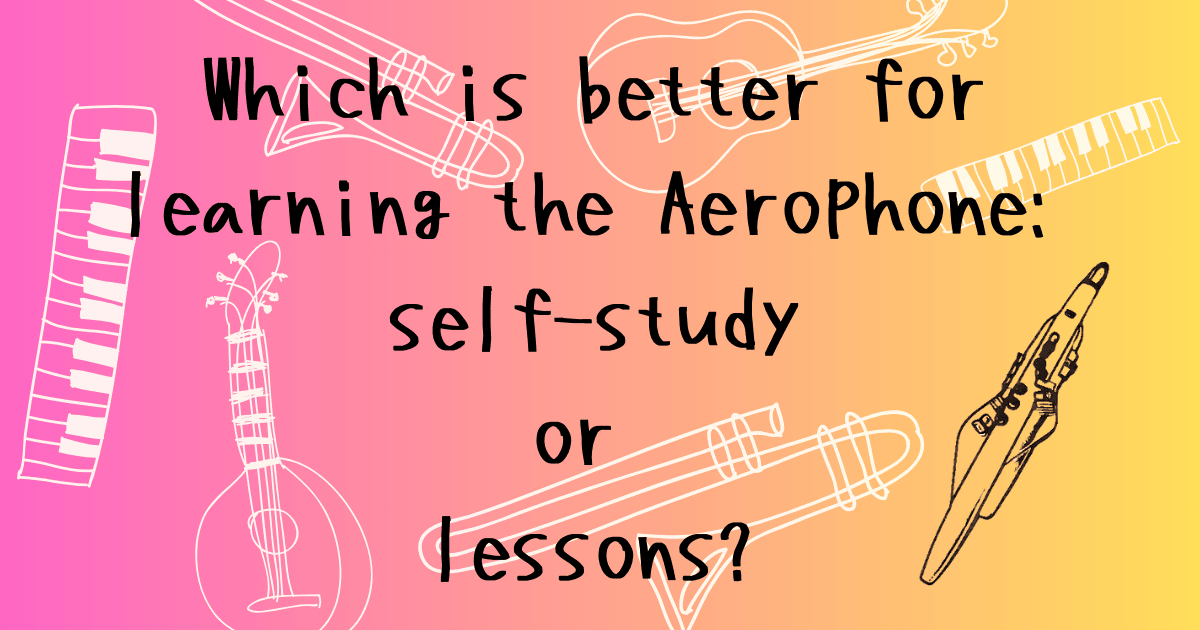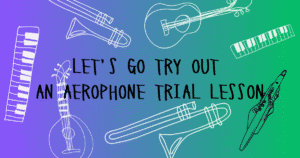Hello, this is Shuko.
Are you thinking about starting the Aerophone or another digital wind instrument?

Whether self-study or lessons are the better option?
For those who are unsure, I’ll introduce the benefits and drawbacks of each approach.
By the way, I personally prefer taking lessons.
Learning from an instructor is really fun!
Why not take the first step and give it a try?


Advantages and Disadvantages of Self-Study
Advantages
1. Lower Financial Burden
The biggest advantage is that it costs less.
Once you purchase the instrument, accessories, and sheet music, there are no ongoing monthly expenses.
2. Complete Flexibility
You can practice anytime, at your own pace, and in whatever way you prefer.
Disadvantages
1. Difficulty in Resolving Questions
After purchasing my Aerophone, I initially took lessons.
However, after about six months, my teacher resigned, and I had to practice on my own for about three months until I found a new instructor.
During that time, I realized how much I wanted someone to answer my questions.
For example, my lower lip would start hurting quickly during practice.
When I searched online, I found that the issue was likely related to my embouchure (the way I held the mouthpiece).
However, I struggled to figure out exactly what I needed to adjust, which was quite frustrating.
2. Harder to Maintain Motivation
While self-study allows complete freedom, I personally found it difficult to stay motivated.
Without strong discipline to set goals and deadlines, I often found myself thinking, “I’ll practice tomorrow instead.”
Even when I managed to play a song, I frequently wondered if I was doing it correctly or if there were ways to improve.


5 Advantages of Taking Lessons & Disadvantages
5 Advantages of Taking Lessons
1. Having Someone Listen to Your Playing Feels Great
Just like the many “I tried playing” videos on YouTube and social media, it’s simply nice to have someone listen to your performance.
Of course, you can ask family or friends to listen, but having a teacher who patiently listens to your practice pieces and gives constructive feedback is incredibly valuable.
2. You Can Ask Questions Anytime
If you struggle with fingerings, rhythm notation, lip pain, air leaking from the sides of your mouth, breath control, dynamics, or making the same mistakes repeatedly, you can ask your teacher for help.
Even if an issue isn’t solved right away, it’s rewarding to see gradual improvement over time.
3. You Receive Personalized Advice
Nowadays, with YouTube, books, and blogs, it’s easier than ever to self-study.
However, these resources provide general advice for a broad audience and may not always suit your specific needs.
For example, my “lip pain problem” improved significantly through trial and error with my teacher’s guidance.
Without that advice, I might have given up due to the pain.
4. Having Assignments and Deadlines (Lesson Days) Increases Practice Time
Lessons often involve working through textbooks or practicing songs.
Wanting to improve before the next lesson naturally encourages more practice.
It’s also highly motivating when your teacher approves your progress on an assignment.
5. It Adds Structure to Your Life (Less Time Wasted on Lazy Weekends)
For me, scheduling lessons has reduced the amount of time I spend idly on weekends.
Before, I would sometimes stay home all day, but having a reason to go out has expanded my activities.
For those taking lessons after work, it helps with time management—ensuring enough practice time and motivating them to finish work efficiently.


Disadvantages of Taking Lessons
1. It Costs Money
The cost varies depending on the number of lessons, duration, and plan, but monthly fees apply.
For major music schools, the average price for three to four 30-minute lessons per month is around ¥12,000.
The cost also differs depending on whether you choose a major school or a private instructor.
Reducing the number of lessons or lesson time can make it more affordable.
2. It Can Be Difficult to Commute, or There Might Not Be a Nearby School
If a music school is far away, commuting can be a hassle.
In some cases, there might not even be a school within a reasonable distance.
Online lessons can solve this problem to a great extent.
Since the COVID-19 pandemic, the availability and quality of online lessons have improved significantly.
In my case, since it takes about an hour and a half to get to my school, I take a combination of online and in-person lessons.
3. Concern About Compatibility with the Teacher
This is something you won’t know until you actually attend a lesson.
However, some issues can be resolved by communicating your preferences and requests.
If you still don’t feel comfortable, it might be best to look for another teacher.
Even outside of music schools, many independent instructors offer lessons, and you can find them on YouTube or through online searches.
4. Feeling Reluctant to Attend Lessons Without Practicing
It’s understandable to feel hesitant about attending a lesson when you haven’t practiced.
In fact, teachers can usually tell right away if a student hasn’t been practicing.
However, they won’t scold you for it.
As an adult learner, you have work, household responsibilities, and many other commitments.
Teachers understand that, and their job is to support you in continuing to enjoy music.
(After all, students are also valued clients!)
Summary
I introduced the advantages and disadvantages of both self-study and taking lessons.
Since I personally prefer taking lessons, I focused more on their benefits.
Although lessons have some drawbacks, many of them can be overcome with a bit of creativity and effort.
If you’re unsure which path to take, I highly recommend trying a trial lesson at least once.
It can be at a music school or with an independent teacher you find on YouTube or online.
At Shimamura Music, you can take lessons for digital wind instruments like the EWI, Yamaha YDS, and Aerophone. Trial lessons are also available!
Take that first step with confidence!
Thank you for reading until the end.



